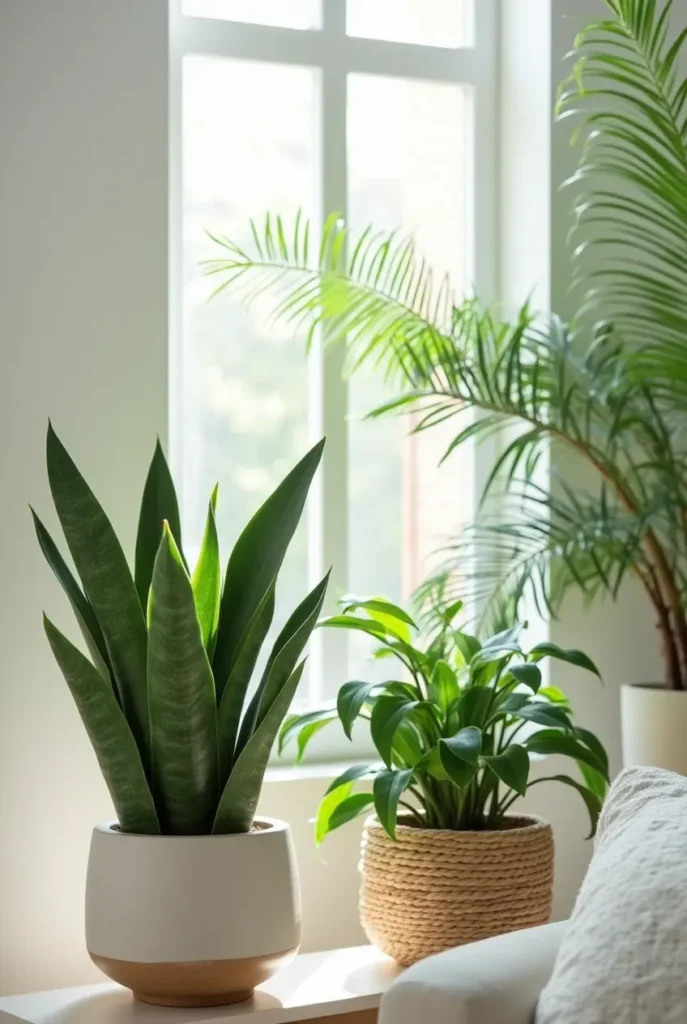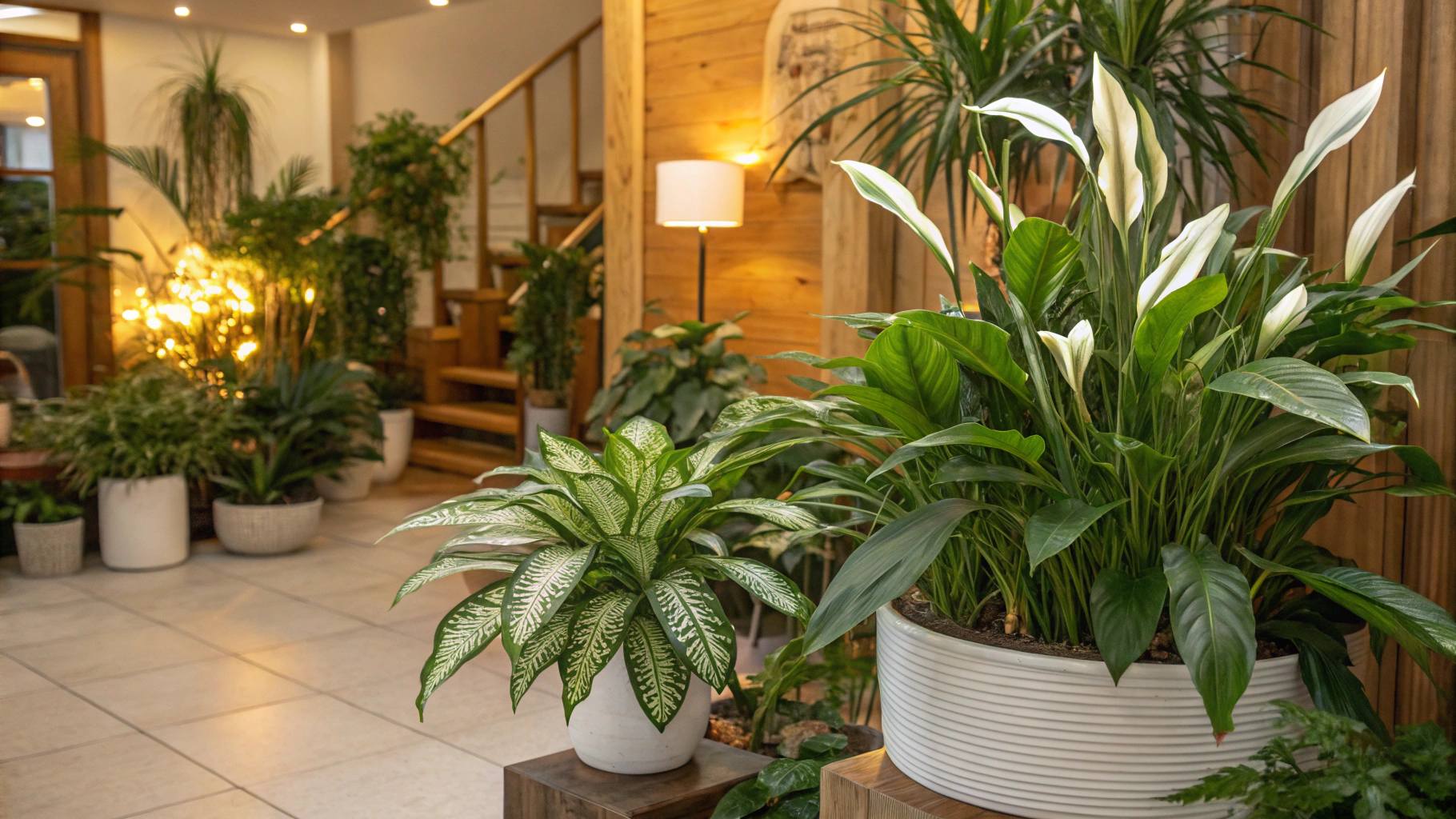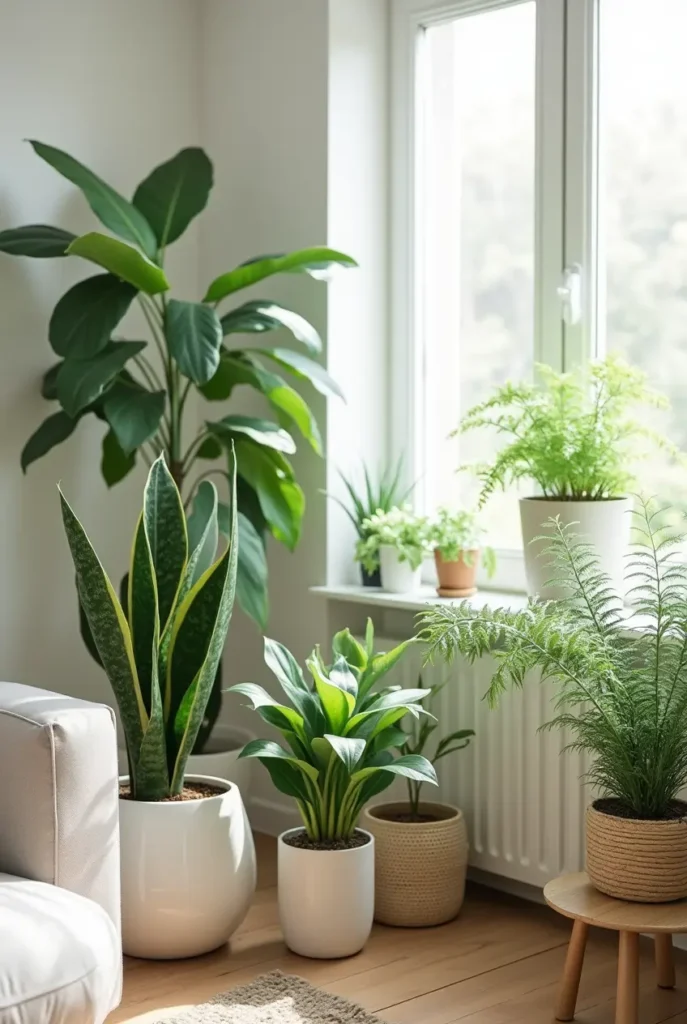There’s something magical about walking into a home filled with lush, vibrant greenery. Beyond their aesthetic appeal, these silent companions are diligently working to purify the very air we breathe. In our increasingly sealed-off modern homes, where indoor air pollution can be up to five times worse than outdoor air, air-purifying plants have become more than just decorative elements—they’re essential allies for our health and wellbeing.
I discovered this firsthand during a particularly difficult winter when persistent respiratory issues plagued my family. After introducing several air-purifying plants throughout our home, we noticed a remarkable difference within weeks—less congestion, fewer headaches, and a palpable freshness to the air we hadn’t experienced before. This personal transformation sparked my journey into understanding how these botanical wonders could so dramatically improve our indoor environment.
Air-purifying plants work tirelessly through a process called phytoremediation, where they absorb harmful toxins through their leaves and roots, converting them into harmless byproducts. NASA’s Clean Air Study confirmed what many cultures have instinctively known for centuries: certain plants are remarkably efficient at removing common indoor pollutants like formaldehyde, benzene, and trichloroethylene from our homes.
In this comprehensive guide, I’ll share the top 15 air-purifying plants that can naturally clean your indoor air, transforming your living space into a healthier sanctuary. Let’s explore these botanical air purifiers that blend beauty with functionality, creating homes that not only look good but help us feel better too.
Table of Contents
Understanding Indoor Air Pollution: The Silent Threat
Common Indoor Air Pollutants
Before we dive into our plant solutions, it’s essential to understand what we’re fighting against. Indoor air pollution comes from numerous sources that might surprise you:
- Volatile Organic Compounds (VOCs): Emitted from paints, furniture, carpets, and cleaning products
- Formaldehyde: Found in pressed wood products, insulation, and many household items
- Benzene: Released by synthetic materials, detergents, and tobacco smoke
- Trichloroethylene: Present in adhesives, spot removers, and typewriter correction fluid
- Carbon Monoxide: From fuel-burning appliances and cigarette smoke
- Particulate Matter: Dust, pollen, pet dander, and other microscopic particles
Health Impacts of Poor Indoor Air Quality
The effects of these pollutants on our health can range from subtle to severe:
| Health Effect | Common Symptoms | Related Pollutants |
|---|---|---|
| Respiratory Issues | Coughing, congestion, asthma attacks | Formaldehyde, particulate matter |
| Neurological Effects | Headaches, dizziness, fatigue | VOCs, carbon monoxide |
| Irritation | Eye, nose, and throat irritation | Benzene, formaldehyde |
| Long-term Concerns | Potential links to heart disease and cancer | Various VOCs, benzene |
The Science Behind Air-Purifying Plants
How Plants Clean the Air
Plants don’t just look pretty—they’re sophisticated air filtration systems working through several mechanisms:
- Stomatal Uptake: Plants absorb pollutants through tiny pores (stomata) in their leaves
- Microorganism Partnerships: Beneficial microbes in soil break down toxins
- Phytoremediation: Plants metabolize harmful compounds into harmless substances
- Transpiration: Creates air circulation that increases filtering efficiency
- Humidity Regulation: Helps reduce airborne dust and pollutants
NASA Clean Air Study: The Scientific Validation
In the late 1980s, NASA conducted the landmark Clean Air Study to find ways to purify air in sealed environments like space stations. Their findings revolutionized our understanding of plants as air purifiers. The study demonstrated that specific plants could remove up to 87% of air toxins in 24 hours under controlled conditions. This research validated what many had intuitively known and provided scientific backing for the use of plants as natural air purifiers.
Top 15 Air-Purifying Plants for Cleaner Indoor Air
1. Snake Plant (Sansevieria trifasciata)
Air-Purifying Capabilities: A superstar among air-purifying plants, the snake plant excels at filtering formaldehyde, nitrogen oxide, benzene, and xylene.
Care Requirements:
- Light: Tolerates low light but thrives in bright, indirect light
- Water: Allow soil to dry completely between waterings
- Soil: Well-draining potting mix
- Special Feature: One of the few plants that convert CO₂ to oxygen at night
Placement Tips: Perfect for bedrooms due to its nighttime oxygen production. Its tall, architectural form works well in corners or as a statement piece.
2. Peace Lily (Spathiphyllum)
Air-Purifying Capabilities: Exceptional at removing formaldehyde, benzene, trichloroethylene, and ammonia. One of the few plants that can reduce mold spores in the air.
Care Requirements:
- Light: Low to moderate indirect light
- Water: Keep soil consistently moist but not soggy
- Soil: Rich, well-draining potting mix
- Special Feature: Wilting leaves provide a visual indicator when watering is needed
Placement Tips: Thrives in bathrooms where it can help reduce mold while enjoying the humidity. Also beautiful on coffee tables where its white blooms can be appreciated.
3. Boston Fern (Nephrolepis exaltata)
Air-Purifying Capabilities: Particularly effective at removing formaldehyde and xylene. Its large frond surface area makes it an efficient air purifier.
Care Requirements:
- Light: Bright, indirect light
- Water: Keep soil consistently moist; benefits from regular misting
- Soil: Rich, organic matter with good drainage
- Special Feature: Natural humidifier, adding moisture to dry indoor air
Placement Tips: Ideal for hanging baskets in kitchens or bathrooms where humidity is higher. Keep away from drafts and heat sources.
4. Spider Plant (Chlorophytum comosum)
Air-Purifying Capabilities: Excellent at tackling formaldehyde, xylene, and carbon monoxide. Can remove 95% of formaldehyde from a sealed chamber in 24 hours.
Care Requirements:
- Light: Bright, indirect light
- Water: Allow top inch of soil to dry between waterings
- Soil: Well-draining potting mix
- Special Feature: Produces “babies” that can be propagated into new plants
Placement Tips: Perfect for hanging planters where the arching leaves and plantlets can cascade down. Great starter plant for beginners.

5. Rubber Plant (Ficus elastica)
Air-Purifying Capabilities: Efficiently removes formaldehyde and other airborne toxins. Its large leaves provide ample surface area for air filtration.
Care Requirements:
- Light: Bright, indirect light
- Water: Allow top inch of soil to dry between waterings
- Soil: Well-draining potting mix
- Special Feature: Glossy leaves that are easy to clean and maintain
Placement Tips: Makes a striking floor plant in living rooms or offices. Can grow quite tall, so provide adequate ceiling space.
6. Aloe Vera (Aloe barbadensis miller)
Air-Purifying Capabilities: Effectively removes formaldehyde and benzene. Also known as a “health monitor” as it develops brown spots when air quality diminishes.
Care Requirements:
- Light: Bright, direct sunlight
- Water: Allow soil to dry completely between waterings
- Soil: Cactus or succulent mix
- Special Feature: Dual-purpose plant with medicinal gel for minor burns and cuts
Placement Tips: Place on kitchen windowsills or sunny spots where its air monitoring capabilities and medicinal benefits can be utilized.
7. English Ivy (Hedera helix)
Air-Purifying Capabilities: NASA’s study ranked it #1 for removing airborne formaldehyde. Also effective against benzene, xylene, and trichloroethylene.
Care Requirements:
- Light: Moderate indirect light
- Water: Keep soil slightly moist; enjoys humidity
- Soil: Rich, well-draining potting mix
- Special Feature: Studies show it can reduce airborne mold by up to 60%
Placement Tips: Excellent in hanging baskets or as trailing plants on shelves. Keep away from pets as leaves are toxic if ingested.
8. Chinese Evergreen (Aglaonema)
Air-Purifying Capabilities: Effectively filters benzene and formaldehyde. Particularly useful in areas with new furniture or recent renovations.
Care Requirements:
- Light: Tolerates low light conditions
- Water: Keep soil consistently moist but not saturated
- Soil: Well-draining potting mix
- Special Feature: Available in various colorful varieties to match any decor
Placement Tips: Perfect for low-light corners and office spaces. Different varieties offer red, pink, or patterned foliage for decorative appeal.
9. Bamboo Palm (Chamaedorea seifrizii)
Air-Purifying Capabilities: Powerful remover of formaldehyde, benzene, and trichloroethylene. One of the highest-rated air-purifying plants in NASA’s study.
Care Requirements:
- Light: Bright, filtered light
- Water: Keep soil consistently moist but not waterlogged
- Soil: Rich, well-draining potting mix
- Special Feature: Can act as a natural humidifier in dry environments
Placement Tips: Makes an excellent room divider or background plant. Its tropical appearance adds a vacation feel to any space.
10. Dracaena (Dracaena spp.)
Air-Purifying Capabilities: Different varieties remove benzene, formaldehyde, trichloroethylene, and xylene. Dracaena marginata is particularly effective.
Care Requirements:
- Light: Bright, indirect light
- Water: Allow top inch of soil to dry between waterings
- Soil: Well-draining potting mix
- Special Feature: Available in many varieties with different colored leaf margins
Placement Tips: Use tall varieties as floor plants and smaller ones as tabletop accents. The corn plant variety (D. fragrans) makes a dramatic statement in living rooms.
11. Golden Pothos (Epipremnum aureum)
Air-Purifying Capabilities: Excellent formaldehyde remover. Also effective against carbon monoxide and benzene.
Care Requirements:
- Light: Tolerates low light but grows faster in bright, indirect light
- Water: Allow soil to dry between waterings
- Soil: Standard potting mix with good drainage
- Special Feature: Nearly indestructible; perfect for beginners
Placement Tips: Versatile trailing plant for shelves or hanging baskets. Can also climb when provided with support.
12. Areca Palm (Dypsis lutescens)
Air-Purifying Capabilities: Removes formaldehyde, xylene, and toluene effectively. Also acts as a natural humidifier.
Care Requirements:
- Light: Bright, indirect light
- Water: Keep soil evenly moist during growing season, slightly drier in winter
- Soil: Well-draining, peat-based potting mix
- Special Feature: One of the best plants for increasing indoor humidity
Placement Tips: Makes a stunning floor plant in living rooms or large bathrooms. Provides a tropical feel to any space.
13. Chrysanthemum (Chrysanthemum morifolium)
Air-Purifying Capabilities: One of the most effective air purifiers, removing ammonia, benzene, formaldehyde, and xylene.
Care Requirements:
- Light: Needs bright, direct sunlight to bloom
- Water: Keep soil consistently moist
- Soil: Rich, well-draining potting mix
- Special Feature: Colorful blooms add aesthetic appeal while purifying air
Placement Tips: Place in sunny windowsills where the blooms can be enjoyed. Consider rotating plants as they’re typically kept for their flowering period.
14. Gerbera Daisy (Gerbera jamesonii)
Air-Purifying Capabilities: Excellent at removing benzene and trichloroethylene. Also produces significant oxygen at night.
Care Requirements:
- Light: Bright, direct sunlight
- Water: Water when top inch of soil is dry; avoid wetting leaves
- Soil: Well-draining potting mix
- Special Feature: Vibrant blooms in multiple colors while purifying air
Placement Tips: Perfect for brightening bedside tables or sunny windowsills. Available in various colors to complement any decor.
15. Weeping Fig (Ficus benjamina)
Air-Purifying Capabilities: Effective at filtering formaldehyde, xylene, and toluene from indoor air.
Care Requirements:
- Light: Bright, indirect light
- Water: Allow top inch of soil to dry between waterings
- Soil: Rich, well-draining potting mix
- Special Feature: Can be trained as a small tree or bush
Placement Tips: Makes an excellent statement plant in living rooms or offices. Dislikes being moved, so find a permanent spot with appropriate light.
Creating an Air-Purifying Plant Strategy for Your Home
Room-by-Room Placement Guide
To maximize the air-purifying benefits of your plants, strategic placement is key:
Living Room:
- Larger floor plants like Rubber Plant, Areca Palm, or Bamboo Palm
- Combine with smaller accent plants like Snake Plants on side tables
Bedroom:
- Snake Plant, Gerbera Daisy, and Peace Lily (all produce oxygen at night)
- Aim for 2-3 medium-sized plants per bedroom
Kitchen:
- Spider Plants and English Ivy to combat cooking fumes
- Aloe Vera on windowsills for both air purification and practical use
Bathroom:
- Peace Lily and Boston Fern to combat mold and absorb excess moisture
- Chinese Evergreen in lower-light bathrooms
Home Office:
- Dracaena, Golden Pothos, and Rubber Plants to combat off-gassing from electronics
- Place plants at eye level for psychological benefits while working
How Many Plants Do You Need?
Research suggests that for optimal air purification:
- Small rooms (up to 100 sq ft): 2-3 medium-sized plants
- Medium rooms (100-300 sq ft): 4-5 medium to large plants
- Large rooms (300+ sq ft): 6-10 plants of various sizes
For actively cleaner air, aim for approximately one medium-sized plant (6-8 inch pot) per 100 square feet of space.
Maintaining Your Air-Purifying Plant Collection
Essential Care Tips
- Dust leaves regularly: Wipe large-leafed plants with a damp cloth; shower smaller plants occasionally to keep their pores clear for maximum air purification
- Monitor humidity: Group moisture-loving plants together or use pebble trays
- Rotate plants: Turn plants regularly to ensure even growth and light exposure
- Repot when necessary: Most plants benefit from repotting every 1-2 years
- Watch for pests: Check regularly for common houseplant pests like spider mites and mealybugs
Seasonal Adjustments
Adjust your plant care routine with the seasons:
- Spring/Summer: Increase watering frequency, fertilize monthly, watch for faster growth
- Fall/Winter: Reduce watering, skip fertilizer, move plants away from cold drafts and heating vents
- Year-round: Maintain appropriate light levels; supplement with grow lights during darker months if necessary
Beyond Plants: Comprehensive Indoor Air Quality Strategy
While air-purifying plants are powerful allies, a holistic approach yields the best results:
- Ventilation: Open windows when possible to introduce fresh air
- Humidity control: Maintain 30-50% humidity for optimal plant function and human comfort
- Air purifiers: Consider mechanical air purifiers as complementary to your plants
- Source control: Reduce chemical cleaners, opt for low-VOC paints and furnishings
- Regular cleaning: Vacuum with HEPA filters, dust surfaces, and wash bedding weekly
Conclusion: Breathing Easier with Nature’s Air Purifiers
Incorporating air-purifying plants into your home is more than just a design choice—it’s an investment in your health and wellbeing. These botanical wonders silently work around the clock, transforming your indoor environment while bringing life, color, and a connection to nature into your personal spaces.
As I’ve experienced in my own home, the benefits extend beyond measurable air quality improvements. There’s a profound psychological benefit to surrounding yourself with living, growing things—a sense of calm, focus, and vitality that transforms a house into a truly nurturing home.
Start with just one or two plants from this list, focusing on those that match your care capabilities and environment. As your confidence grows, gradually expand your indoor garden, creating a diverse ecosystem of air-purifying plants that work together to keep your indoor air fresh, clean, and healthy.
Remember, in bringing these plants into your home, you’re not just decorating—you’re participating in one of nature’s most elegant solutions for cleaner air and healthier living spaces.
FAQ: Common Questions About Air-Purifying Plants
Which air-purifying plants are best for beginners?
Snake Plants, Golden Pothos, and Spider Plants are extremely forgiving and ideal for those just starting their air-purifying plant collection. They tolerate inconsistent watering and various light conditions while still effectively cleaning indoor air.
Are air-purifying plants safe for pets?
Not all air-purifying plants are pet-friendly. Peace Lilies, English Ivy, and many Dracaena varieties are toxic to cats and dogs. Pet-safe air-purifying options include Spider Plants, Boston Ferns, Areca Palms, and most Calatheas.
How quickly do air-purifying plants clean the air?
While plants continuously clean the air, noticeable improvements typically require adequate plant quantities. Studies suggest that a medium-sized room needs at least 3-5 actively growing plants to experience measurable air quality improvements within a few weeks.
Do air-purifying plants lose their effectiveness over time?
Air-purifying plants maintain their cleaning abilities as long as they remain healthy. Regular care—including dusting leaves, proper watering, adequate light, and occasional fertilizing—ensures they continue functioning as effective air purifiers.
Can air-purifying plants replace air purifiers?
While air-purifying plants significantly improve air quality, they work best as part of a comprehensive strategy. For serious air quality concerns, especially in highly polluted areas or for those with respiratory conditions, plants work excellently as complements to mechanical air purifiers.


